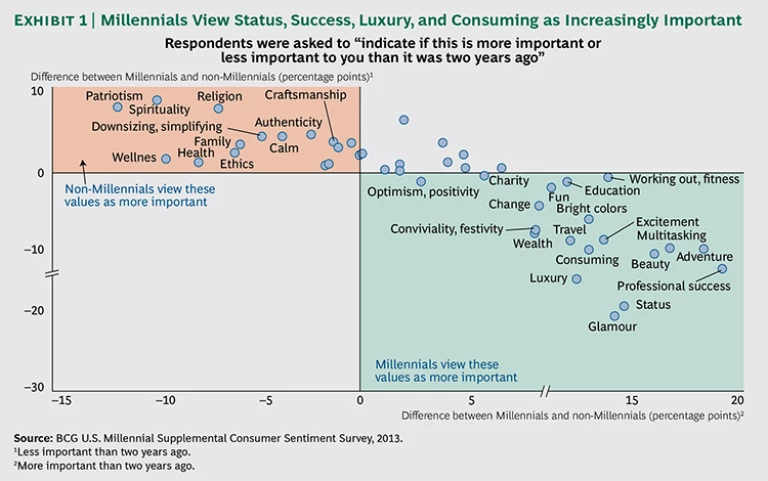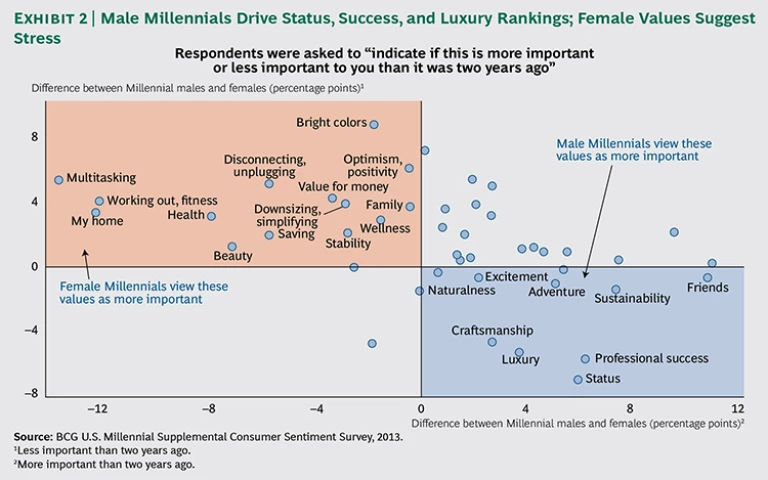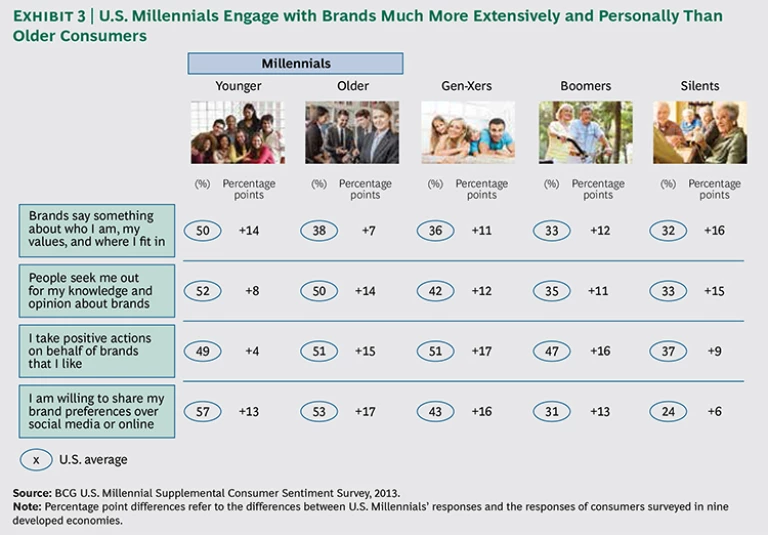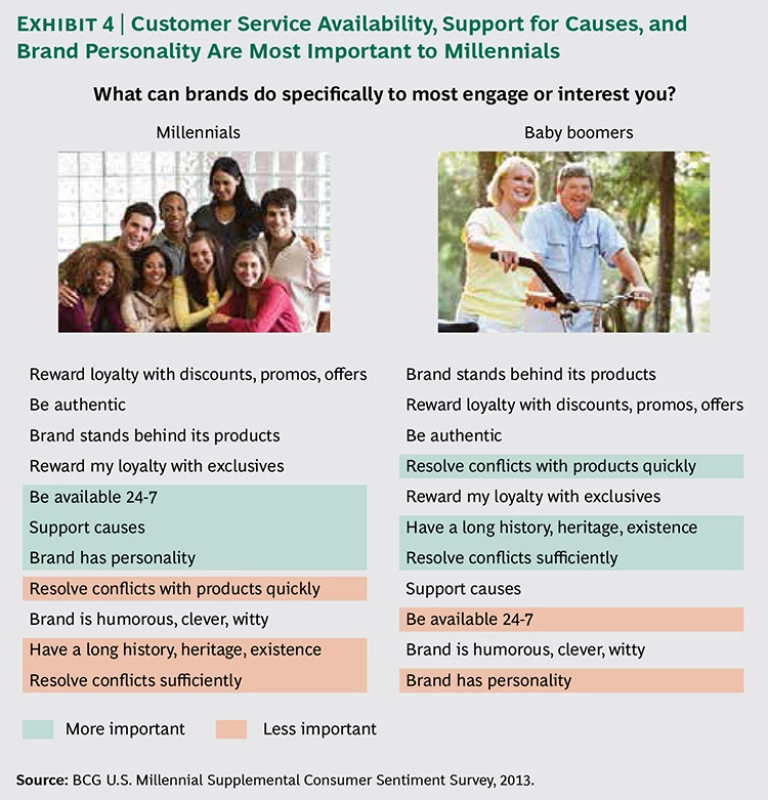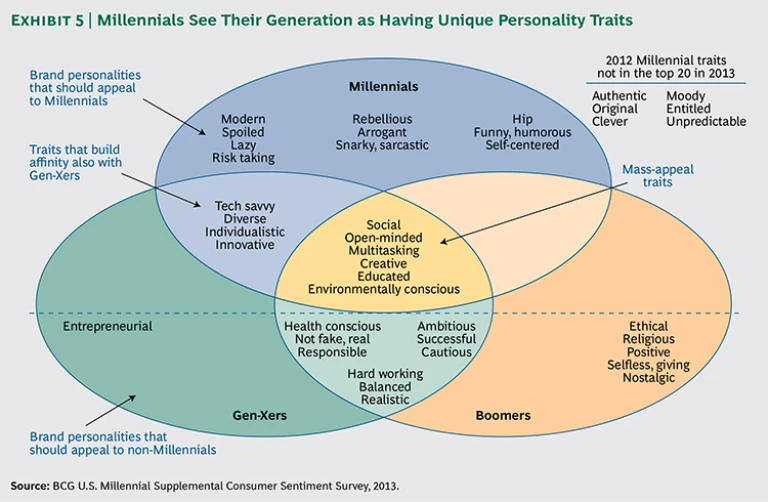Companies: you should already be ready. Success in marketing to U.S. Millennials—the generation of people now 18 to 34 years old—will be critical to companies across product and service categories.
It is perhaps more important that this generation is transforming consumer marketing itself. Millennials are distinguished from older generations by their spending habits, brand preferences, values, personalities, and general outlook on life. Furthermore, they engage with brands far more extensively, personally, and emotionally—and in entirely different ways—than have other generations.
Millennials expect a two-way, mutual relationship with companies and their brands. We call this the reciprocity principle. Through the feedback they express both offline and online, Millennials influence the purchases of other customers and potential customers. They also help define the brand itself. The Internet, social media, and mobile devices greatly amplify Millennials’ opinions and accelerate their impact. Companies can expect that a positive brand experience will prompt Millennials to take favorable public action on behalf of their brand. A bad—or even just disappointing—experience can turn a Millennial into a vocal critic who will spread the negative word through social media, reviews, and blogs. And that criticism can go viral.
In marketing, as in pop culture, Millennials are leading indicators of large-scale changes in future consumer behavior. They are influencing and accelerating shifts in consumer attitudes, spending habits, and brand perceptions and preferences among Gen-Xers and even baby boomers. As a result, this generational transition is ushering in the end of consumer marketing as we have long known it.
The conventional, linear framework that most companies have used to manage brand engagement no longer holds. Executives and marketers must embrace the new reality: marketing is an ecosystem of multidirectional engagement rather than a process that is controlled and pushed by the company.
Millennials are also leading indicators of the new “status currency”—the status and values that consumers wish to project through their purchasing decisions and their brand affiliations.
If they have not already begun to do so, companies must make marketing to Millennials a top strategic priority and begin to master the art of two-way reciprocal marketing. Companies are already finding that pushing consistent, prepackaged brand messages to the masses through traditional media is not as effective and cost efficient as it once was—certainly not with Millennials, nor increasingly with Gen-Xers and boomers.
Executives and marketers will need a comprehensive, intimate view of Millennials across channels and media. Companies must place a high priority on transforming their marketing functions by breaking down organizational silos and building the capabilities and partnerships needed to succeed in the new reciprocal-marketing ecosystem. To start, companies and marketing organizations need to set and communicate clear and measurable Millennial goals. They should reach out to Millennials, wherever they are, with a cross-media, cross-channel, and cross-device brand presence. Brands should reinforce their authentic reputations with the right brand values, personalities, and communications. They should relate to Millennials by moving from push communications to two-way, open dialogue. And they should cultivate Millennial referral among customers as well as Millennial employees.
The Reciprocity Principle
The conventional framework that most companies have used to approach marketing is often depicted as a funnel, with the company at one end and the customer who has made a purchase at the other. A company starts by defining the positioning, benefits, and personality of its brand. It then pushes that image down to consumers in an attempt to build awareness and, eventually, customer loyalty.
This simple description of a linear relationship between investment in brand awareness and marketing outcomes may have been valid in the past, but this framework is outdated. Instead of being a process that is led and pushed by companies, modern marketing is an ecosystem that is influenced by some factors that a company can control and some that are beyond its control. It is a system in which marketers, customers, and potential customers perpetually exchange experiences, reactions, emotions, and buzz.
A more effective marketing approach will be driven by the reciprocity principle. For the purposes of this report, we describe five key elements of this principle: reach, relevance, reputation, relation, and referral. Like any other ecosystem, the new marketing environment is dynamic, and its boundaries are fluid. Millennials are influencing each of these elements in profound ways.
- Reach. Millennials are digital natives. They are more technologically savvy than other generations, and they use portable devices more extensively to access the Internet while physically visiting stores. Companies must use the full array of available media, as well as mobile devices, to reach these consumers and build brand awareness as cost-effectively as possible. In addition to using traditional marketing vehicles that are trusted by Millennials, such as public relations and endorsements, companies should increase their investments and capabilities in digital marketing, social media, advocacy, and cause marketing.
- Relevance. Millennials, whose values differ from those of older generations, are distributed among a wide range of life’s stages: while some have started families, for example, others still live with their parents. Yet others are first-time independents. Their brand choices, moreover, are influenced by more and different kinds of people. Companies must be aware of all this to make their brands relevant and appealing.
- Reputation. Because Millennials identify more personally and emotionally with brands, it is especially important that brands strive to maintain genuine reputations that reinforce the traits, personalities, values, and causes that Millennials hope that they project about themselves.
- Relation. Companies must maintain a two-way dialogue with Millennial consumers. They must listen to them, incorporate their feedback and input, and quickly respond to them and their concerns in a personal and straightforward manner.
- Referral. To build brand loyalty and persuade Millennials to be positive advocates of their brands, companies must build an ongoing relationship through individual and online community communications, social media, and advocacy programs.
How Millennials Are Transforming Marketing
To gain an in-depth understanding of this enigmatic and influential generation, we surveyed nearly 800 Millennials and more than 1,700 non-Millennials in the U.S. as part of our 2013 Global Consumer Sentiment Survey. We complemented this survey with a 2013 study of more than 400 U.S. Millennials and nearly 1,000 non-Millennials, covering values, brand engagement, and marketing tactics. Finally, we compared 2013 results with findings from 2012 global research involving more than 1,200 U.S. Millennials. Our global research and experience suggests that our findings about U.S. Millennials and their impact on consumer marketing reflect similar trends among Millennials in other developed countries.
We compared the responses of Millennials with those of consumers of other generations—Gen-Xers (ages 35 to approximately 49), baby boomers (ages approximately 50 to 69), and the so-called silents (ages approximately 70 and older). There is great diversity within the Millennial generation itself, so we further segmented this generation into two age cohorts—younger Millennials (ages 18 to 24) and older Millennials (ages 25 to 34). We also segmented Millennials by gender and income group.
Although U.S. Millennials are hardly a homogeneous population, we believe that generalizations based on our research illustrate the profound impact this generation is having on marketing—and are useful in understanding the reciprocity principle in terms of reach, relevance, reputation, relation, and referral.
Reaching Millennials. It is not surprising that U.S. Millennials are considerably more engaged with digital technology and social media than older generations. In fact, 37 percent of younger Millennials said that they feel as if they are “missing something” if they are not on Facebook or Twitter every day, compared with 23 percent of non-Millennials.
Moreover, Millennials, as heavy users of portable devices, are also connected to brands wherever they go: 67 percent of Millennials reported that they use smartphones to access the Internet. That compares with 40 percent of baby boomers and just 20 percent of silents. Furthermore, 82 percent said that they access the Internet with laptop computers and 47 percent with tablets (up from 26 percent in 2012), both significantly higher than older generations.
U.S. Millennials are also more likely to use portable media devices on the go: 46 percent said that they access search engines such as Google while they are in a store, compared with 29 percent of baby boomers. Around twice as many Millennials as boomers said that they check prices, look up product information, or search for coupons or promotions on their mobile devices while they are in a store. Forty-three percent of Millennials—compared with 25 percent of boomers—reported that they search for information online while in stores.
Millennials also engage with brands more deeply through social networks: 52 percent said that, at least occasionally, they use their mobile devices on social media to note that they “like” a brand, compared with 33 percent of boomers. Also, 39 percent post product reviews, 35 percent share links about products on LinkedIn, and 32 percent said that they follow brands on Twitter. In each case, the percentage of Millennials who reported these activities exceeded that of boomers by 150 to 250 percent.
Responding to our 2013 survey, the 43 percent of U.S. Millennials who reported that they check for coupons or promotions on their smartphones while they are in a store represent a dramatic increase from the 24 percent who responded similarly in 2012. As connected consumers, therefore, Millennials can—and do—engage with brands everywhere they go.
Establishing Relevance. It is more difficult through traditional marketing to convince a U.S. Millennial than an older U.S. consumer that a brand is relevant to him or her. Millennials turn to much wider networks for advice, for example. The Millennials we surveyed reported that, on average, their purchasing decisions are influenced by five people, compared with three for boomers.
Millennials are also influenced by different types of people. Traditionally, companies have used testimonials from “experts,” such as doctors or financial advisors, to convince consumers of the merits of a brand. But less than half of Millennials said that they trust expert advisors, compared with 61 percent of non-Millennials. And a mere 4 percent of Millennials—compared with three times as many boomers and silents—said that they are most influenced by experts. In our 2012 survey, we also detected a marked shift among Millennials away from advertising as a stated trusted source of brand advice.
Instead, U.S. Millennials reported that they are most influenced by family, friends, and strangers. Asked to name the type of people who influence their purchasing decisions, 59 percent of Millennials listed friends—compared with less than half of non-Millennials. Of the Millennials, 52 percent cited spouses and partners, and 51 percent cited parents; 33 percent, roughly twice as many as non-Millennials, listed strangers, and 23 percent cited celebrities. Millennials were twice as likely as Gen-Xers to say that they are influenced by celebrities, four times more likely than boomers, and ten times more likely than silents. Indeed, the influence of celebrities on Millennials appears to have increased since our 2012 survey, especially when it comes to apparel, lifestyle, and luxury categories and brands.
The Internet is a more influential source of consumer information for U.S. Millennials than for older generations: 50 percent of younger Millennials and 47 percent of older Millennials said that they trust retailer websites, compared with 33 percent and 36 percent of Gen-Xers and boomers, respectively. Millennials also expressed significantly greater trust in company social media as well as digital advertising.
U.S. Millennials display levels of egocentrism that exceed what may be expected considering their youth. This inward focus can be seen today in the values they expressed: 35 percent said that they believe that beauty is more important to them than it was two years ago, while 37 percent cited wealth and 45 percent, professional success. Significant percentages of Millennials also said that status, luxury, consuming, adventure, excitement, and travel are increasingly important to them. Non-Millennials place much higher importance on such values as patriotism, spirituality, religion, and calm. (See Exhibit 1.)
Our survey found that both Millennial men and women focus on themselves. They differ, however, in their emphasis on specific values. Male Millennials attach a greater importance to external recognition, citing values such as status, professional success, luxury, and craftsmanship.
The responses of Millennial females seem to indicate greater anxiety and stress: among the leading values that they said had become more important over the past two years were disconnecting and unplugging, fitness, and simplifying. U.S. Millennial females’ values are consistent with our 2012 findings. The values of Millennial males differ even more starkly from those reported by females in our 2012 survey. Females cited such values as tradition and stability, as well as reassuring, familiar, and grounding influences such as locally grown, home, local communities, family, and spirituality. In 2012, females also placed greater emphasis on such new status-currency values as wellness, saving, and naturalness. It is surprising that far fewer female Millennials cite professional success as more important in our most recent survey. (See Exhibit 2.)
Burnishing Brand Reputation. Millennials identify with brands more personally and emotionally than do older generations. Fifty percent of U.S. Millennials ages 18 to 24 and 38 percent of those ages 25 to 34 agree that brands “say something about who I am, my values, and where I fit in.” (See Exhibit 3.) That sentiment is substantially stronger among Millennial males than females and among those in middle- and high-income brackets (around 40 percent) than those who consider themselves as being in lower-income brackets (27 percent). In our 2012 survey, 59 percent of Millennials reported that the brands they bought reflected their style and personality; 40 percent said that they were willing to pay extra for a brand or product that reflected the image they wished to convey about themselves, compared with only 25 percent of non-Millennials.
Reflecting the new status currency, Millennials view brands as extensions of their own values and status. To win their loyalty, therefore, companies must do more than deliver high-quality products. Indeed, only 22 percent of U.S. Millennials said that brands must “stand behind” their products, compared with 42 percent of boomers. Through their actions, storytelling, and endorsers, companies should express the traits and affiliations that Millennials wish to project about themselves.
Cultivating Relationships. To sustain Millennial loyalty to their brands, companies must engage Millennials individually and in small groups through direct, two-way communications. More than other generations, Millennials desire opportunities to interact with brands, to be listened to anywhere and anytime, and to have personal, timely, and straightforward communication about their concerns and experiences.
Millennials were asked to name the most important things brands can do to “engage and interest” them: their top two responses were to reward their loyalty with discounts and promotions and to “be authentic.” These were also high on the lists of Gen-Xers and boomers. But more Millennials than other generations also listed being available, supporting causes, and having a brand personality. (See Exhibit 4.)
A brand’s availability 24-7 is significantly more important to U.S. Millennials than to others. Nearly twice as many Millennials as boomers cited that benefit as the most important thing that brands can do to engage them. Moreover, females expressed a stronger desire that their loyalty be acknowledged with recognition, rather than blanket material rewards, implying that a company should have knowledge of them as individuals and that each of them has a relationship with the brand.
Brands must also connect with Millennials’ new status currency. This generation has a stronger affinity than other generations for brands that express themselves as socially responsible. Forty-eight percent of young Millennials reported that they “try to use brands of companies that are active in supporting social causes.” When asked whether “brands should help those in need,” more Millennials than the U.S. average agreed that they are more likely to buy a product if they know that the company is “mindful of its social responsibilities” and that they buy from companies that “show concern for the environment and sustainability.” Furthermore, 45 percent of U.S. Millennials said that environmental stewardship is more important to them as a value now than it was two years ago.
Inspiring Millennials to Make Brand Referrals. Engaging U.S. Millennials after a purchase is not only critical to keeping them as customers; it is important also because Millennials are more eager than other generations to share their opinions with friends and on social networks. More than half of U.S. Millennials said that people seek them out for their knowledge and opinions of brands, compared with only 35 percent of boomers. More Millennial males than females said that they think that they are sought out for their brand and purchase opinions. In fact, Millennials said that they believe that they influence the brand and purchase decisions of around four family members and friends. Boomers, by comparison, say that they influence around two. That means Millennials can become especially powerful cross-generational advocates of brands—as well as influential critics. A company’s capabilities in promoting advocacy and social media, therefore, are increasingly important.
More than half of U.S. Millennials said that they are willing to share their brand preferences on social media, compared with 31 percent of baby boomers. More Millennial females than males said that they are willing to share brand preferences over social media or online. Millennials are around 2.5 times more likely than boomers to at least occasionally share a social-media link that references a brand or product and to follow brands on Twitter. They are also far more likely than boomers to support their favorite brands online: 52 percent said that they post likes of a brand on social media such as Facebook, and 21 percent reported that they do so “every time” or “almost every time.” Also, 39 percent said that they post reviews of brands or products, 27 percent reported that they reference a brand in blog posts, and 26 percent said that they answer satisfaction surveys on mobile devices.
The brand choices of U.S. Millennials are also more likely to be influenced by peers than are those of older consumers. In fact, 28 percent of younger Millennials and 23 percent of older Millennials said that they are more likely not to purchase or use brands that their friends disapprove of. Only 12 percent of boomers agreed. Millennial males are twice as concerned as females with peer approval of their brand affiliations. This means that peer recommendation or disapproval should influence Millennials’ purchasing behavior more than it does that of non-Millennials.
BCG research confirms that brands that are highly recommended by consumers outperform brands that are heavily criticized. In a sample that we studied for
Keeping the Message Relevant. To engage and win over Millennial consumers, it is critical to make sure that marketing messages, brand communications, and tone resonate. Millennials’ response to the same visual images differs from that of their parents, for example. Companies should strive for messages that speak authentically to the attitudes, beliefs, preferences, and personalities of U.S. Millennials. Because Millennials are such a diverse generation, moreover, communications should also be tailored to appeal to Millennial segments.
One general trait that clearly distinguishes Millennials from older consumers is their optimism. Although their job prospects were hit disproportionately hard by the economic downturn, 69 percent of U.S. Millennials reported that their personal situations and outlooks are bright, compared with 42 percent of non-Millennials. Furthermore, 58 percent of Millennials overall said that they enjoy “peace of mind,” 60 percent report happiness with their lives now, and 47 percent said they “have enough fun.” Twice as many Millennials as Gen-Xers said that they believe their generation will have a better life than previous generations.
The tone of marketing communications should also reflect the Millennial “personality.” To get a sense of how Millennials view themselves, we asked survey respondents to cite terms that uniquely describe their generation. The most common prompted responses in 2013 were technologically savvy, young, modern, risk taking, rebellious, hip, and funny or humorous, and—unprompted—smart and fun. Millennials also cite less flattering self-descriptions, such as lazy, arrogant, snarky or sarcastic, and self-centered. Trendy and energetic were more popular in this year’s survey than in last year’s.
This self-image differed dramatically from that of boomers, who more commonly mentioned such traits as ethical, religious, selfless or giving, and nostalgic. Millennials also expressed less interest in several traits that rank high for boomers and Gen-Xers, such as responsible, hard working, and ambitious.
Do all three generations share any common ground? Mass traits that appeal most to Millennials as well as Gen-Xers and boomers include social, open-minded, multitasking, creative, and environmentally conscious. Millennial traits that should also build affiliation with Gen-Xers are diverse, individualistic, and innovative. (See Exhibit 5.) In our 2012 survey, Millennials also cited authentic, original, and clever.
The choice of visual imagery is also critical. Most marketers are sensitive to the need to reflect ethnic and racial diversity in visual images. When marketing to Millennials, they must also be increasingly sensitive to diversity in family structures and gender roles. Depictions of traditional nuclear families do not resonate with many Millennials. More and more, parents are regarded as “friends.” More moms work; more dads stay at home. Marketers should also take into account that, given their age, Millennials are in different stages of life. Many are still in their late teens, and many who are in their twenties are still living at home with their parents. Some are on their own for the first time, while others already have spouses and children.
Brand imagery, messages, and promotions should also take into account that many U.S. Millennials are highly group oriented, even when it comes to activities such as travel and eating out. Companies should, therefore, consider using visuals that are multigenerational and that show groups—friends, classmates, work colleagues, multigenerational families, cultural “tribes,” or strangers coming together for a common cause.
Implications for Marketers
Companies targeting the Millennial generation should align their strategies, initiatives, and investments around the reciprocity principle. To make well-informed investment and business decisions and position the company to target consumer segments, executives and marketers need an integrated, comprehensive view of consumers across channels and in terms of their lifetime value as customers.
If they haven’t already begun to do so, companies must transform their marketing organizations in at least three ways. First, there should be fewer organizational silos separating such functions as digital marketing, private-brand organizations, public relations, analytics, and pricing. Second, they must build the new organizational capabilities and partnerships required to succeed in a reciprocal ecosystem. Third, companies should shift marketing investment from traditional media to more innovative media and tools that can measure short- and longer-term returns from marketing.
We suggest the following tactics.
Set and communicate clear, measurable goals. Few companies outside sectors in which Millennials are currently core customers—for example, quick-service restaurants and apparel—devote sufficient strategic attention and investment to this generation. Nor do they have sufficient methods for measuring progress. One way to encourage accountability is to publicize Millennial objectives within the company—and potentially among investors and customers—and report on how well those objectives are being met. Companies should adopt an annual Millennial marketing plan that is based on an integrated, holistic approach that brings together planning, media mix, campaigns, and tactics into a single view to achieve the company’s overarching objectives for this segment. Programs should be reviewed at least annually to assess whether they are effectively and efficiently achieving such marketing and enterprise objectives as acquisition of Millennial customers, share of Millennial spending, customer retention, advocacy, employee diversity, and improved brand image or fame.
Reach Millennials with a cross-media, cross-channel brand presence. Most companies still devote too much of their planning and budget mix to traditional media—television, newspapers, radio, and catalogs—and not enough to more innovative media. To engage with Millennials where they are, a brand must be present across the full range of media, through offline and online channels, and on mobile devices.
Companies need to know which media, channels, and devices work best at conveying promotions, messaging, and brand personality to Millennial targets, and they should use each to its unique advantages. In addition, most companies haven’t yet fully developed the capabilities they need to offer relevant content through online, e-mail, or mobile devices at the right time. Nor have they mastered the ability to monitor customer uptake, understand return on marketing investment, or scale up online and mobile platforms.
Make sure marketing communications are relevant. To reach Millennial consumers, companies must make sure that their marketing communications are optimistic and positive in tone. They should also visually portray the generation as broadly diverse and inclusive. Companies targeting Millennials in certain sectors should not ignore the marketing value of testimonials from celebrities and partnerships with Millennials’ favorite or aspirational brands.
Our research found that Millennials perceive themselves as particularly in tune with what they consider to be authentic and real. Millennials tell us that the most common mistakes of non-Millennial creative agencies and executives are marketing campaigns that come across as fake, overly forced, condescending, or off key. Therefore, marketing language, brand personalities, company-supported causes, and endorsements need to be credible. They should be based on what the brand has stood for historically, how the product and experience deliver on that promise, and the actions the brand has taken.
Reinforce reputation in Millennial channels. A company can connect with the new status currency by demonstrating to Millennials that its brand’s soul is aligned with their values and that customers are doing good by purchasing that brand. Companies should show that they help those in need, are good environmental stewards, are socially responsible, respect personal data, or are transparent. Companies can act meaningfully by creating nonprofit partnerships that promote the causes they support, adopting new codes of corporate conduct, and improving their hiring, people management, sourcing, and manufacturing practices.
Relate to Millennial constituents. Companies need to invest in nontraditional marketing initiatives and organizational capabilities that allow them to build relationships with Millennials. The goal should be to cultivate more of a one-on-one or small-community connection with customers and potential customers. Such initiatives might include events, recognition, referral programs, testimonials from influencers, customer advisory panels, social media, online community marketing, public relations, customer-relationship-management programs, and e-mail campaigns.
A company’s own Millennial employees can be valuable in helping it relate better to Millennial consumers. Few companies fully leverage these human assets. Such staff can prove powerful brand advocates or even more powerful critics. Millennial employees can be effectively engaged in numerous ways. Like Millennial customers, they can serve on a Millennial advisory board or help develop products, services, and marketing strategies through so-called crowdsourcing. Millennial employees can also serve as a company’s face and voice in retail channels and social media. Companies should place top Millennial talent in the right management and leadership roles today, particularly in online channels and in marketing and product functions. Human resources departments should incorporate Millennial-marketing lessons into their core processes—and share Millennial-employee lessons with marketers.
Cultivate Millennial referral. Although companies cannot control whether and how consumers advocate for their products, they can cultivate and measure relationships with consumers who are most likely to influence their target market. They can also influence brand conversations. An effective plan requires an online and offline referral-marketing program that allows customers to interact with the brand and each other and to deepen each customer’s relationship with the company. Another key is to proactively address criticism on social media with contriteness and candor. Companies should reflect what they know about Millennials in their customer-service strategy and in the tactics they use for addressing complaints and questions, such as the availability of service representatives, response times, and online or video chat.
Finally, companies need an advocacy plan for identifying consumers in each community or network who exert especially strong influence over Millennial customers or potential customers. We call these influencers the critical 2 percent because they account for a tiny share of a Millennial community but have disproportionate sway, opening doors to the rest of that community. Once the company has identified these influencers, it should invest to acquire an in-depth understanding of this 2 percent and develop strong relationships with them. Few companies employ insightful metrics that track the performance of their referral and advocacy initiatives effectively. We recommend tracking the number of interactions with all Millennial customers, customer recommendations, and advocates that generate content. Companies should also measure the quality and sentiment of interactions with their Millennial customers and the critical 2 percent over time.
The imperative to engage and win over the Millennial generation represents an entirely new set of challenges for U.S. marketers. This is especially true for long-established companies that are accustomed to pushing consistent, polished messages from the top but have little experience maintaining true two-way relationships with customers. Companies that are able to master the reciprocity principle will have a competitive advantage not only when it comes to attracting and retaining the valuable Millennial generation. They will also be more successful at appealing to customers across other generations who are rapidly changing the way they interact with brands.
Acknowledgments
This report would not have been possible without the efforts of our BCG Millennial Panel: Antonio Alvarez, Lindsey Barnes, Matthew Innamorati, Delvin Kelly, Jeffrey Shaddix, Bensey Schnip, Amy Snyder, and especially Brian Bunyard, Hannah Davis, Christopher Harlan, and Angela Zhang. Furthermore, the authors want to thank Marguerite Fitzgerald, Richard Hutchinson, Tom Lutz, Kim Plough, Bettina Schönenberger, and Miki Tsusaka for their invaluable leadership and support.
